Hey there!
According to Code Brew, global ecommerce sales are projected to grow from $4.9 Trillion in 2021 to $7.4 Trillion by 2027, while Europe’s market will expand from $46 Billion in 2020 to $111.4 Billion by 2025.
Trying to understand the difference between a single vendor vs multi vendor marketplace?
In this guide, we’ll explain how these two ecommerce models work, their key differences, and what they mean for business owners and shoppers.
Whether you’re launching an online store or exploring different platforms, knowing the pros and cons of each marketplace type will help you make the right choice.
Let’s dive into the features, benefits, and challenges of single vendor vs multi vendor marketplaces to find out which suits your needs best!
Key Takeaways on Single Vendor Vs Multi Vendor Marketplace
- Single vendor vs multivendor marketplace affects business growth. Multivendor platforms expand quickly with multiple sellers, while single vendor businesses grow steadily.
- Managing a single vendor marketplace is easier. Multi vendor marketplaces need better vendor coordination, proper logistics, and strong quality control to keep everything running smoothly.
- Revenue models vary: single vendor businesses rely on direct sales, while multiple vendors in a multivendor marketplace generate income through commissions, ads, and vendor subscriptions.
- Brand consistency is easier in a single vendor setup, while multi vendor marketplaces face challenges in maintaining uniform product quality, pricing, and customer experience.
- Risk is distributed in a multivendor marketplace, reducing dependency on a single supplier, whereas single vendor businesses are more vulnerable to supply chain disruptions.
Build a Scalable Marketplace with Multi Vendor Innovation!
What is a Marketplace?

A marketplace is a platform or environment where buyers and sellers engage in transactions involving goods, services, or information. It serves as an intermediary, streamlining the process of exchange by providing a space for both parties to connect.
Marketplaces can be physical or digital and often feature a wide range of products or services. They simplify transactions by offering a structured environment where participants can interact, negotiate, and complete exchanges efficiently.
Definition of a Marketplace in Ecommerce
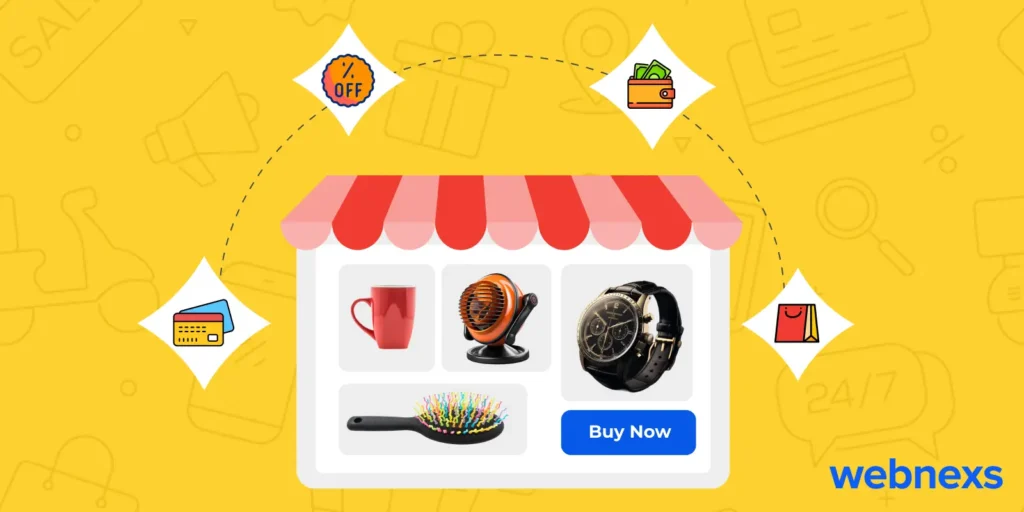
Global marketplace sales will hit $7.4T by 2025. 85% of consumers shop online, with China (52.1%) and the U.S. (20.1%) leading. Amazon dominates U.S. ecommerce with 40% market share.
An ecommerce marketplace is an online platform where multiple sellers can offer their products for sale to customers. Rather than each seller having to create and manage their website, they can sell their goods through a shared platform.
The marketplace typically handles important aspects like processing payments, providing customer support, and sometimes even managing shipping. Sellers are responsible for managing their inventory and listing their products with accurate details.
Popular examples of ecommerce marketplaces are Amazon, eBay, Etsy, and Alibaba. These platforms make it easier for customers to shop by providing a wide variety of products from different sellers in one convenient location.
What is a Single Vendor Marketplace?

Single Vendor Meaning refers to a marketplace model where a single vendor or seller offers products to various customers through a dedicated website.
In a single vendor marketplace, only two parties are involved: the buyer and the seller. These marketplaces are also called stand-alone vendor solutions because they focus on a single seller managing all product listings.
While this model provides direct vendor-to-customer interactions, it generally has less traffic than multi vendor marketplaces due to a limited product range. The seller is responsible for managing inventory and listings through the platform’s backend.
Single Vendor Marketplace Examples:
Single vendor marketplaces include platforms like Nike.com, Tesla Store, Warby Parker, Glossier, and Lush, where a single company controls product sales, offering a range of products directly to consumers through their own dedicated websites.
What is a Multi Vendor Marketplace?
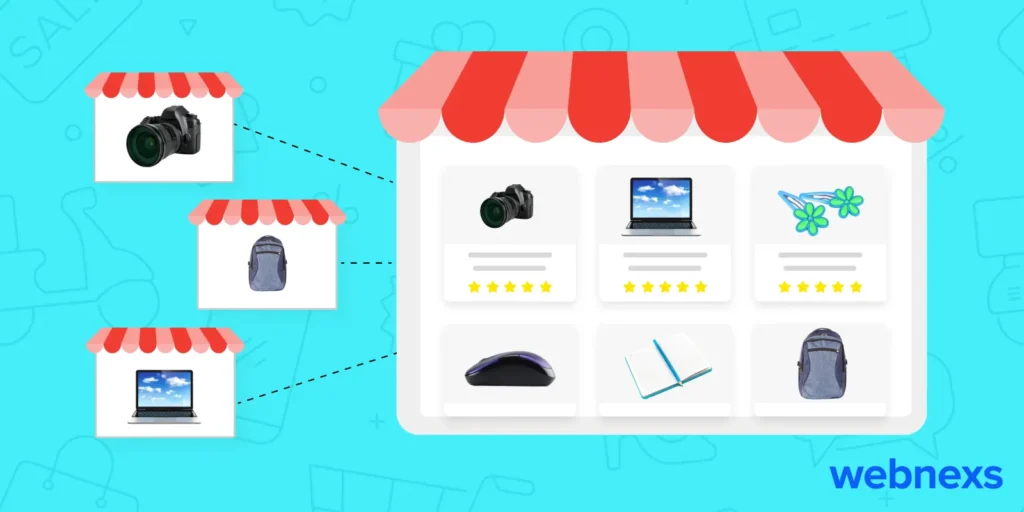
The multi vendor marketplace industry is growing rapidly, with the global market expected to reach $75 billion by 2025. Businesses adopting this model see increased scalability, diverse revenue streams, and improved customer engagement.
Multi Vendor Meaning refers to an online marketplace model where multiple sellers come together to sell their products on a single platform, resulting in higher profits. This model enables numerous transactions between sellers and customers.
Generally, in a multi vendor software system, multiple suppliers list their products on a marketplace managed by an administrator. Customers/buyers visit the platform and get the opportunity to purchase from various sellers or brands.
This setup allows customers to choose from a wide range of products, significantly increasing site traffic. In a multi vendor strategy, three key entities are involved: Admin, Vendor, and Customer.
Various types of vendors register on the admin’s site to sell their products, making it a scalable and profitable ecommerce model.
Multi Vendor Marketplace Examples:
Multi vendor marketplaces include platforms like Amazon, eBay, Etsy, AliExpress, Walmart Marketplace, Rakuten, Target+, Flipkart, Best Buy Marketplace, and Mercado Libre, where multiple sellers offer a wide variety of products on a single platform.
Single Vendor vs Multi Vendor Ecommerce Marketplace Difference in the Technology Stack
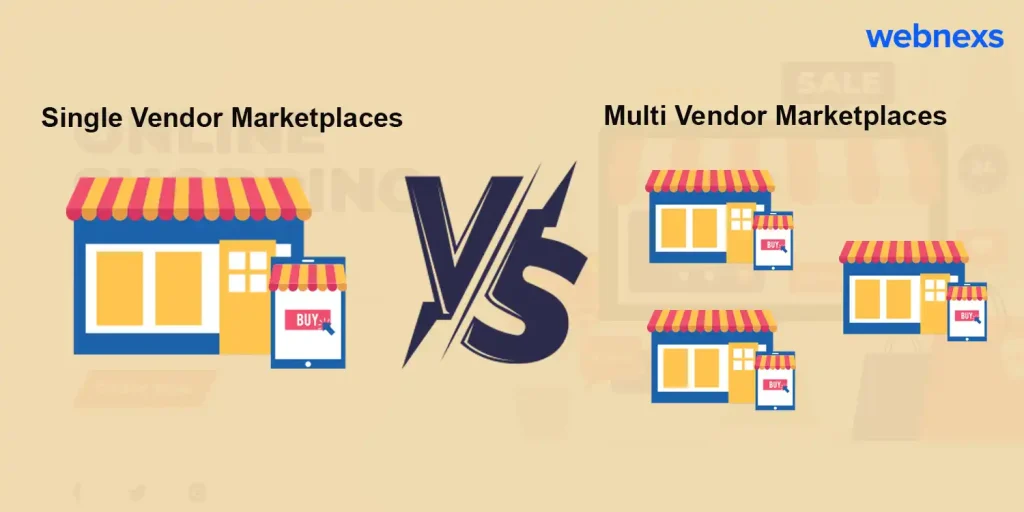
| Technology Stack | Single Vendor | Multi Vendor |
| 1. Scalability and Architecture | Considering the single vendor size, monolithic architecture will suffice with lightweight backend technology such as PHP (Laravel) or Django that will be effective in delivering optimum performance. | Scalability is pivotal to success by deploying a microservices architecture, allowing independent scaling of components to accommodate more sellers, products, and users. |
| 2. Database Complexity | Due to its nature of limited complexities and fewer datasets, relational databases like MySQL or PostgreSQL are often sufficient. | In contrast to the above, it requires sophisticated database management. It utilizes non-relational databases to handle unstructured and varied data. |
| 3. Vendor Management & Permissions | Simplified admin and customer-centric access are granted. This demands to a certain extent basic authentication only. | It involves a complex hierarchical structure of user management for admins, sub-admins, vendors, and customers. As a result, a Role-Based Access Control framework or custom solutions are deployed. |
| 4. Payment Processing | The simplicity in its nature allows for handling payments directly to the seller. | It calls for advanced payment processing procedures to split payments among multiple vendors. Embedding escrow services is quite common to secure payments until product delivery. |
| 5. Search and Filtering | Basic search capabilities using SQL queries or a simple integration like Elasticsearch. | Advanced search with multiple filters, potentially requiring Elasticsearch or Algolia to efficiently handle the search experience across multiple vendor products. |
| 6. CMS and Marketplace Functionality | Advanced vendor-specific features are not required extensively, which makes these tools suitable without a higher scope for customization. | It provides individual storefronts, vendor dashboards, commission management, and multi vendor catalog integration. |
| 7. Notifications and Communication | Communication between buyer and admin is facilitated using basic email or SMS notifications. | Communication between buyers, admin, and multiple vendors is facilitated using real-time messaging systems. |
| 8. Third-Party Integrations | Limited integration needs, mostly focusing on payment, shipping, and CRM. | Requires integration with multiple CRMs, shipping providers, tax management systems, and ERP systems to manage different vendors’ requirements. |
| 9. Analytics and Reporting | Reporting mainly focuses on sales, customer activity, and traffic analytics, which can be handled using simpler analytics tools. | It requires complex dashboards and custom reporting tools are necessary for analyzing different vendors’ data. |
Factors to Consider Before Choosing Single Vendor Vs Multi Vendor Platform
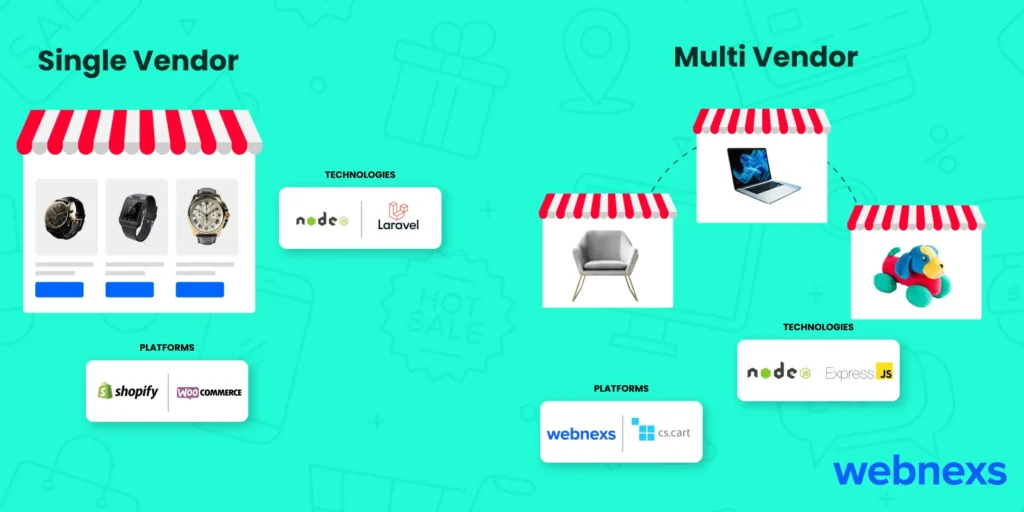
1. Nature of the Business
Online marketplaces come in different models, and the way they operate depends on how the business is structured. Some companies sell their products directly to customers, while others offer a platform for various sellers. The model you choose will affect how much control you have, your growth potential, and the experience you deliver to customers.
Single Vendor Marketplace
A Single Vendor Marketplace is perfect if you want full control over things like branding, pricing, and inventory. Platforms like Shopify, WooCommerce, or Webnexs work well for this.
With technologies like Node.js or Laravel for the backend and React.js or Vue.js for the front end, the platform can run smoothly and fast. A structured database like PostgreSQL or MySQL helps with order management, while payment processors like Stripe or PayPal make transactions easy.
Benefit: This setup gives you total control, ensuring brand consistency, customer trust, and smoother logistics. It’s ideal for niche businesses that want to offer a seamless experience.
Multi Vendor Marketplace
On the other hand, a Multi Vendor Marketplace allows multiple sellers to list their products. Platforms like Webnexs, CS-Cart, or Magento 2 Multi Vendor are great for this.
Managing vendors is easy with a backend that scales well (using Node.js and Express) and a frontend built with React.js or Angular. Payment systems like Stripe Connect or Razorpay Route handle multiple payments without complications.
Benefit: A Multi Vendor Marketplace allows you to offer a wide range of products without managing inventory, helping your business grow faster and reach more customers.
Actionable Insights: If you want full control over your brand, go for a Single Vendor Marketplace. If you want a scalable model with diverse products, choose a Multi Vendor Marketplace.
2. Scalability
Scalability is all about making sure your platform can grow without slowing down or running into performance issues.
Single Vendor Marketplace
Scalability isn’t as critical because one seller handles all the operations. You can rely on cloud services like AWS EC2, Google Cloud, or DigitalOcean to keep things running smoothly.
Cloudflare CDN is also helpful for handling high traffic. Databases like PostgreSQL with replication or Firebase Firestore keep data processing stable.
Business Benefit: Since you don’t need massive infrastructure, the costs are lower, and operations are simpler. This is perfect for small and medium businesses (SMBs) that want an easy-to-manage platform.
Multi Vendor Marketplace
Multi vendor software needs a setup that can scale much more easily. Using tools like Docker and Kubernetes for microservices, along with serverless options like AWS Lambda or Google Cloud Functions, allows your platform to scale dynamically.
Distributed databases, such as Sharded MongoDB or Amazon RDS, help handle large amounts of data and transactions.
Business Benefit: This type of setup ensures your platform is ready for growth, supporting millions of users without any downtime.
Actionable Insight: If you’re expecting significant traffic growth, it’s smart to invest in cloud-native, serverless solutions to avoid performance issues down the road.
3. Level of Operational Complexity
The complexity of managing an ecommerce marketplace varies based on its structure. While single vendor platforms offer simpler operations, multi vendor marketplaces require advanced management systems to handle diverse sellers and processes efficiently.
Single vendor marketplace
A vendor marketplace is much easier to handle because you’re only managing one seller. Platforms like Webnexs Shopify, or WooCommercehave built-in inventory tools, and automation tools like Zapier or HubSpot can help simplify tasks like order processing and customer communication.
Business Benefit: With fewer moving parts and lower costs, it’s much easier to scale a single brand business. This setup is ideal for small or medium-sized businesses that want to grow without dealing with complex operations.
Multi Vendor Marketplace
Multi vendor requires more effort to manage, as you have to handle multiple sellers. Platforms like Webnexs, CS-Cart, or Yo! Kart comes with tools to help onboard vendors and keep things running smoothly.
Middleware solutions like GraphQL or RabbitMQ ensure vendors can interact with the platform without issues, and tools like Power BI or Metabase allow you to monitor how vendors are performing.
Business Benefit: A Multi Vendor Marketplace helps you grow quickly while spreading out the work. It’s perfect for large-scale businesses that need to manage many sellers and products.
Actionable Insight: To make managing your marketplace easier, consider investing in automation and data analysis tools. These can help you stay on top of vendor management and improve efficiency as you scale.
4. Revenue Model
The way an ecommerce marketplace generates revenue depends on its structure. While single vendor platforms typically earn through direct sales, multi vendor marketplaces leverage commissions, subscriptions, and listing fees for diversified income streams.
Single Vendor Marketplace
A vendor marketplace focuses on selling products directly to customers, with payment options like Stripe, PayPal, or Razorpay for transactions.
Business Benefit: You can keep a larger share of the profits, but growth is limited by how much inventory you can manage.
Multi Vendor Marketplace
A Multi Vendor Marketplace, on the other hand, can make money through commissions, subscriptions, and advertising. Payment systems like Stripe Connect, Razorpay Marketplace, or PayPal Mass Payments help automate payments to vendors.
Business Benefit: This model creates multiple ways to earn, making it more scalable and profitable as the business grows.
Actionable Insight: To boost revenue, consider using AI for dynamic pricing and running targeted ads to increase sales.
Step into the Future with Multiple Vendors Advantages!
5. User Experience
The user experience in an ecommerce marketplace depends on factors like product variety, platform performance, and service consistency. While single vendor platforms ensure a uniform experience, multi vendor marketplaces offer more choices but require strict quality control.
Single Vendor Marketplace
Offers a consistent shopping experience with front-end technologies like React.js, Next.js, or Vue.js. Search tools like Elasticsearch or Algolia can help improve the search function.
Business Benefit: This setup leads to higher customer retention and stronger brand loyalty.
Multi Vendor Marketplace
Multi vendor software provides customers with more product choices but requires AI-driven tools like Nosto or Dynamic Yield for personalized shopping experiences. Tools like Hotjar and Google Analytics 4 can track user behavior to help improve engagement.
Business Benefit: This model attracts price-conscious shoppers and makes it easier for customers to discover new products.
Actionable Insight: To boost user engagement, use AI chatbots and offer real-time personalization to create a better shopping experience.
6. Investment and Maintenance Costs
Investment Costs are initial expenses for acquiring assets or resources, such as equipment, land, and buildings, that contribute to long-term value. Maintenance Costs are ongoing expenses for repairs and upkeep to ensure optimal asset performance.
Single Vendor Marketplace
Single vendor requires a lower initial investment with a simpler tech stack (Webnexs, Shopify, WooCommerce).
Business Benefit: Ideal for startups and SMBs with limited capital.
Multi Vendor Marketplace
Multi vendor needs a higher investment due to vendor management tools, commission tracking, and payment distribution. Using serverless computing and API-driven architecture can reduce long-term costs.
Business Benefit: High growth potential, but requires strong financial backing.
Actionable Insight: Invest in SaaS-based solutions to reduce development costs and speed up time-to-market.
7. Product Range and Variety
Product Range refers to the variety of products a company offers, covering different categories to meet the diverse needs of its customers.
Variety describes the different options within that range, such as styles, features, and specifications.
Single Vendor Marketplace
A platforms built on Webnexs, Shopify, or WooCommerce usually have a limited product range since all products come from one business.
A Node.js or Laravel backend with a React.js frontend ensures a smooth shopping experience, and tools like Algolia’s AI-powered recommendation engine can help customers find products more easily.
Business Benefit: This model allows businesses to maintain brand exclusivity and target niche markets with a unique product offering.
Multi Vendor Marketplace
Multi vendor software like those built with Webnexs Multi Vendor, CS-Cart, or Magento 2 Multi Vendor, offers a much wider product range because multiple vendors contribute different items.
Using search tools like Elasticsearch or Solr makes it easy for customers to browse, and AI-based personalization tools like Nosto help boost engagement.
Business Benefit: This approach attracts a larger customer base, which increases sales and platform traffic.
Actionable Insight: To improve product discovery and conversion rates, invest in AI-driven search and filtering tools to make it easier for customers to find what they’re looking for.
8. Marketing and Branding
Marketing involves strategies to promote products, while Branding is about creating a unique identity for a business to build customer loyalty.
Single Vendor Marketplace
Businesses can easily establish a strong, consistent brand identity across all products and services. Tools like SEMrush and Ahrefs for SEO, along with email marketing platforms like Mailchimp, help boost brand visibility.
Business Benefit: A strong brand identity leads to better customer recognition and higher loyalty, encouraging repeat purchases.
Multi Vendor Marketplace
It’s more challenging to maintain a consistent brand image because different vendors may have different practices.
Using AI-driven content management systems like WordPress with AI plugins can help ensure uniform branding. Additionally, programmatic advertising tools like Google Ads and Meta Ads allow for targeted marketing.
Business Benefit: This model can drive more traffic and engagement, but you need solid brand management to maintain a consistent identity across all vendors.
Actionable Insight: Use AI-powered content moderation tools to enforce branding guidelines and ensure consistency across all vendors on your platform.
9. Vendor Management
Vendor Management is all about selecting, overseeing, and maintaining good relationships with suppliers to ensure smooth operations and reduce risks.
Single Vendor Marketplace
Managing vendors is easier because the business handles its own inventory and supply chain. Tools like Odoo or Zoho Inventory help simplify procurement, while automation tools like Zapier make workflows more efficient.
Business Benefit: With simpler operations, businesses can work more efficiently and reduce costs.
Multi Vendor Marketplace
Vendor management becomes more complex since you need to handle multiple suppliers. Platforms like Webnexs Multi Vendor, Mirakl, or CS-Cart provide built-in tools to manage vendors, track their performance, and handle payments.
Payment solutions like Stripe Connect or PayPal Mass Payments automate payouts to vendors.
Business Benefit: Streamlined vendor management helps ensure products are always available and allows the marketplace to grow more easily.
Actionable Insight: Implement automated systems to track and score vendor performance, allowing you to focus on your best sellers.
10. Logistics and Fulfillment
Logistics is about planning and managing the movement of goods, while Fulfillment ensures that orders are processed correctly and on time.
Single Vendor Marketplace
Businesses have full control over logistics and can work with third-party fulfillment services like ShipBob, ShipStation, or Amazon FBA to handle deliveries efficiently.
Business Benefit: Having consistent and reliable deliveries helps improve customer satisfaction and encourages repeat business.
Multi Vendor Marketplace
Logistics can be more complicated because multiple vendors are involved. To handle this, you’ll need to integrate with shipping aggregators like Shippo, EasyPost, or ShipperHQ.
AI-powered logistics platforms like Route4Me can help optimize delivery routes.
Business Benefit: This setup allows the marketplace to grow, but it’s important to have a clear shipping policy in place to ensure consistency across vendors.
Actionable Insight: Use real-time tracking APIs to give customers more transparency and better visibility on their deliveries.
11. Risk and Liability
Risk refers to potential uncertainties that could impact business operations, while Liability is about the legal responsibilities for any damages or losses that occur.
Single Vendor Marketplace
Risks are mainly concentrated within the business. These include issues like managing inventory, staying compliant with regulations, and handling returns. Using tools like OneTrust can help automate compliance and ensure that policies are followed.
Business Benefit: With everything under one roof, businesses have more control over risk management, making operations less unpredictable.
Multi Vendor Marketplace
Risks are shared across various vendors. However, if one vendor provides poor quality or bad service, it can negatively impact the platform’s reputation. AI-based fraud detection systems like Riskified or Sift can help reduce some of these risks.
Business Benefit: Risk is spread out across multiple vendors, but it’s important to have strong quality control measures in place to protect the marketplace’s reputation.
Actionable Insight: Consider using AI-powered tools to help resolve disputes and manage risks associated with vendors.
12. Target Audience
Target Audience refers to the specific group of consumers a business aims to reach with its products or services.
Single Vendor Marketplace
This model is ideal for targeting niche audiences, like luxury brands or specialized products. Tools like HubSpot or Zoho CRM, which use AI, help businesses better understand what customers want and need.
Business Benefit: With highly focused marketing, businesses can achieve higher conversion rates by appealing directly to their target audience.
Multi Vendor Marketplace
The platform caters to a wider range of customers, offering a variety of products. Using data analytics tools like Google Analytics 4 or Mixpanel, businesses can track and analyze customer behavior to understand what drives traffic and sales.
Business Benefit: The ability to offer a diverse selection of products can attract more visitors and boost overall traffic.
Actionable Insight: Use AI-driven audience segmentation to create personalized marketing campaigns that speak to the unique interests and preferences of different customer groups.
13. Platform Requirements
Platform Requirements refer to the necessary tools and systems to make sure a marketplace works well.
Single Vendor Marketplace
Single vendor things are simpler. You mainly need tools to manage inventory, process payments, and track orders. Platforms like Shopify, WooCommerce, and Magento make it easy to set up and run the business without needing much technical knowledge.
Business Benefit: This type of setup keeps things straightforward, helping businesses save time and money when launching.
Multi Vendor Marketplace
The setup is more complex. You’ll need features for managing multiple vendors, tracking commissions, and supporting different payment options. A headless commerce system, using things like GraphQL APIs and microservices, gives you the flexibility to scale as the business grows.
Business Benefit: A more advanced system allows your platform to grow with your business, but it requires more investment in both time and technology.
Actionable Insight: To set up a marketplace that can grow with your business, invest in flexible technology that will allow you to adapt and scale as needed.
14. Time to Market
Time to Market refers to how quickly a platform can be launched and start operating.
Single Vendor Marketplace
It’s faster to get up and running. This is because the process is simpler, and there are ready-to-use solutions like Shopify, BigCommerce, or WooCommerce that make the setup easy.
Business Benefit: A quick launch means you can start generating revenue sooner.
Multi Vendor Marketplace
On the other hand, takes longer to develop. This is because it involves managing multiple vendors, handling commissions, and setting up more complex workflows. However, using SaaS-based marketplace builders like Webnexs or Sharetribe can help speed up the development process.
Business Benefit: While it takes more time to build, a multi vendor platform has more potential for growth in the long term, but it requires thorough planning and testing.
Actionable Insight: To speed up the process, consider using low-code or no-code platforms, which can help launch your marketplace faster without needing much coding expertise.
How to Scale from Single Vendor to Multi Vendor Marketplace?
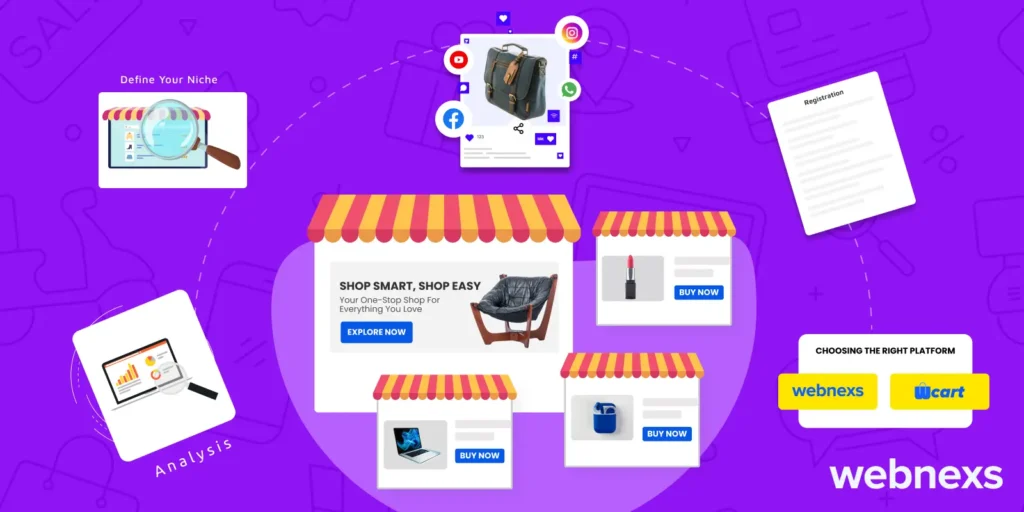
1. Market Research and Analysis
The first step in this journey is thorough market research. Understanding the demand for various products and services within your target market is essential.
Analyze competitors to identify market gaps and assess customer preferences through surveys or feedback mechanisms. This groundwork will help you establish a strong foundation for your multi vendor marketplace.
2. Define Your Niche
Once you’ve gathered insights, it’s crucial to define your niche. Determine whether your marketplace will focus on a specific category of products or a broader range.
A well-defined niche can help you establish a unique value proposition, making it easier to attract both customers and vendors.
Your value proposition should articulate what differentiates your marketplace whether it’s pricing, product variety, or superior customer service.
3. Platform Selection and Technology
Choosing the right platform is pivotal. Decide whether to build a custom solution or use existing ecommerce platforms like Webnexs, or Wcart, which offer multi vendor capabilities.
Ensure that the chosen platform is scalable and can accommodate increased traffic and transactions as more vendors are onboarded.
4. Develop a Vendor Onboarding Strategy
A robust vendor onboarding strategy is essential. Create clear criteria for vendor selection, ensuring they meet quality standards and align with your marketplace’s values.
Develop a streamlined onboarding process, making it easy for vendors to register, list products, and access training resources. This efficiency encourages more sellers to join your platform.
5. Implement Vendor Management Tools
To facilitate smooth operations, invest in vendor management tools. Providing a dedicated vendor dashboard allows sellers to manage their inventory, sales, and performance metrics.
Establish communication channels for vendors to seek support and receive updates, ensuring they feel connected and valued within your marketplace.
6. Create a Revenue Model
A well-defined revenue model is crucial for sustainability. Consider implementing a commission structure where you earn a percentage of each sale, or explore listing fees and subscription models.
Make sure your pricing is competitive to attract vendors and consider offering incentives for early adopters to encourage participation.
7. Enhance User Experience
User experience is paramount in retaining customers and encouraging purchases. Focus on designing a user-friendly, visually appealing website that enables easy navigation and product discovery.
Robust search and filtering options can help customers find products from various vendors efficiently.
8. Marketing and Promotion
Effective marketing is vital for attracting both vendors and customers. Utilize digital marketing strategies, including SEO, social media campaigns, and content marketing, to boost visibility.
Encourage vendors to promote their products through the marketplace by offering marketing support, such as featured listings or promotional discounts.
9. Customer Support and Community Building
Provide exceptional customer support to address inquiries and issues swiftly. Establish a knowledge base for both customers and vendors to find answers to common questions.
Foster community engagement by creating spaces for interaction, such as forums or social media groups, which can enhance brand loyalty and encourage repeat business.
10. Monitor and Optimize Performance
Regularly monitor performance using analytics tools to track vendor success, sales metrics, and customer behavior.
Establish a feedback loop where both vendors and customers can provide input on their experiences. Use this information to identify areas for improvement and optimize operations continually.
11. Expand Gradually
Finally, consider a phased rollout. Start with a small group of vendors to test processes and refine your platform before gradually expanding your offerings.
Continuous improvement based on insights from each phase will enhance vendor onboarding, customer experience, and operational efficiency.
Actionable Insights: Successfully Scale to a Multi Vendor Marketplace, Strategic vendor onboarding, scalable technology, and a strong revenue model are key to growth. Enhance user experience, optimize marketing, and continuously monitor performance to ensure long-term marketplace success.
Expand Your Reach with Multiple Vendors Platform!
Advantages of Single Vendor Marketplace
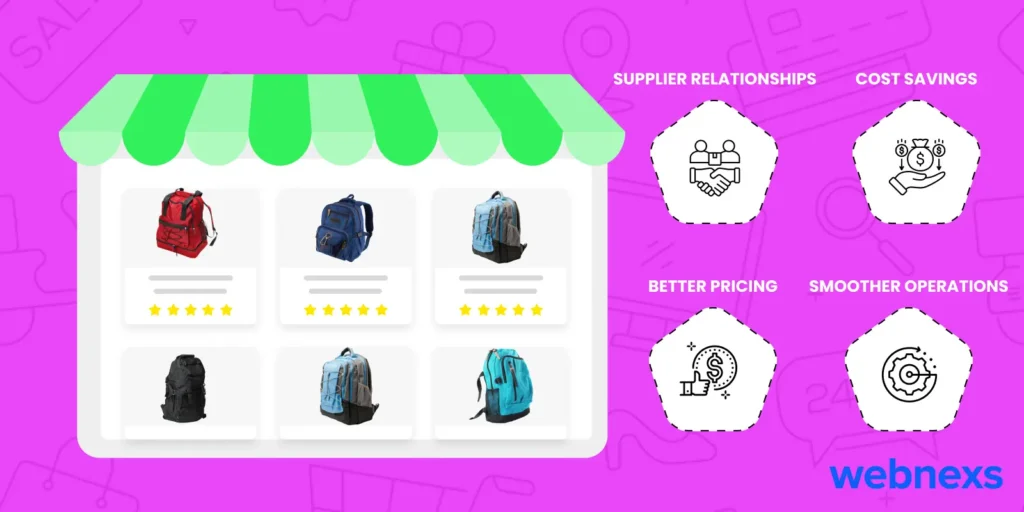
As ecommerce is set to reach $7.4 trillion by 2026, businesses are constantly seeking ways to stay competitive.
Adopting a single vendor strategy can be a great way to streamline operations. Whether you’re managing a website that sells only your products or working with a single supplier, this approach offers several clear benefits.
When you choose a single vendor strategy, you’re simplifying your sourcing by sticking with just one supplier. This can make life easier in several ways:
- Simpler Supplier Relationships: It’s a lot easier to manage one supplier than several. With one vendor, you get to build a stronger relationship, making communication smoother and processes more reliable.
- Cost Savings: Working with just one supplier means less paperwork, fewer negotiations, and lower administrative costs. You can streamline your purchasing process and focus on what matters.
- Better Pricing: The more you order from one supplier, the better your chances of negotiating a great price. A single vendor strategy helps you leverage volume for better deals.
- Smoother Operations: When you only have one supplier to manage, everything from ordering to delivery becomes simpler. It’s much easier to track inventory and manage logistics when you’re not dealing with multiple vendors.
- Easier Inventory Control: A single vendor strategy gives you more flexibility to arrange deliveries that suit your business needs. Smaller, more frequent orders can help you keep inventory at the right level without overstocking.
Incorporating single vendor concepts can help you save time, cut costs, and create a more efficient supply chain. It’s a practical approach that can make a real difference in how you run your business.
Real-Life Success Story for Single Vendor Marketplace
Gymshark
Gymshark, a billion-dollar fitness brand, scaled using a single vendor marketplace model, retaining full control over branding and pricing.
By leveraging headless commerce, influencer marketing, and data-driven strategies, it built a strong DTC presence.
This approach helped Gymshark achieve a $1.3 billion valuation, proving the power of a focused single vendor marketplace strategy.
Enhance Your Store with Single Vendor Marketplace Platform!
Advantages of Multi Vendor Marketplace
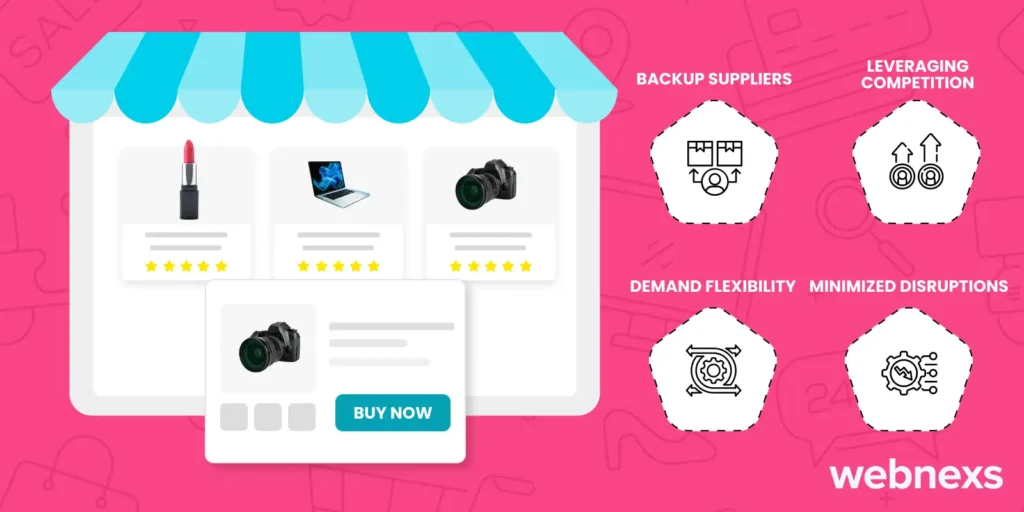
The multi vendor marketplace industry is projected to hit $73.2 billion by 2030, driven by scalability, diverse revenue streams, cost efficiency, and improved customer engagement, making it a profitable ecommerce model.
For small to medium-sized businesses, relying on a single supplier can feel risky, but managing multiple suppliers can quickly become complicated. This is where a multi vendor website builder comes in, providing a streamlined solution to manage several vendors within one platform.
With the right multi vendor marketplace software, businesses can easily handle multiple suppliers, gaining greater flexibility and reducing potential risks. This setup allows businesses to scale more efficiently, maintain smooth vendor coordination, and remain competitive in the market.
Here are a few reasons why working with multiple suppliers, especially through a multi vendor ecommerce website, can benefit your business:
- Backup Suppliers: With multiple suppliers, your business is protected from disruptions. If one faces issues like financial troubles or acquisition, others can fulfill your needs, ensuring stability in your supply chain.
- Leveraging Competition: Multiple suppliers give you the advantage of competition. You can negotiate better prices, faster deliveries, and improved service, making your multi vendor ecommerce website more competitive in the market.
- Demand Flexibility: Working with several suppliers allows you to adjust your order volumes based on fluctuating demand. This flexibility helps you manage seasonal peaks or sudden changes in customer behavior, without relying on just one vendor.
- Minimized Disruptions: A multi vendor marketplace helps safeguard against disruptions in your supply chain. If one vendor faces delays or issues, you have alternatives ready to ensure that your business operations continue without interruption.
Read More: 15 Must-Have Multi Vendor Ecommerce Website Features
Real-Life Success Story for Multi Vendor Marketplace
Amazon
Amazon’s multi vendor marketplace thrives by offering a massive variety of products from third-party sellers.
Features like customer reviews, easy returns, and Fulfillment by Amazon (FBA) ensure a trustworthy shopping experience.
Amazon’s global reach and advanced logistics have made it a dominant e-commerce force, benefiting both sellers and buyers.
Elevate Ecommerce with Our Multivendor Marketplace Platform!
We’ve explored the details of both single vendor and multi vendor marketplaces.
Understanding the strengths of each model can help you choose the right approach for your business goals and market needs.
1. Risk mitigation? Multi vendors
2. Seeking stability? Single vendor
3. Specialized market? Multi vendors
4. Integration ease? Single vendor
5. High complexity? Multi vendors
Conclusion
Choosing between a single or multi vendor marketplace depends on what your business needs. With the right technology, you can pick the model that best supports your growth and helps you reach your goals.
✅ For Small Businesses & Niche Brands: A Single Vendor Marketplace is ideal if you want to keep things simple and maintain full control over your brand.
✅ For Larger Marketplaces: A Multi Vendor Marketplace works better when you need more automation, data-driven insights, a wide range of products, and scalable cloud infrastructure.
🚀 Webnexs offers easy-to-use, flexible solutions for both single and multi vendor marketplaces giving you the tools to build, grow, and succeed in the ecommerce world.
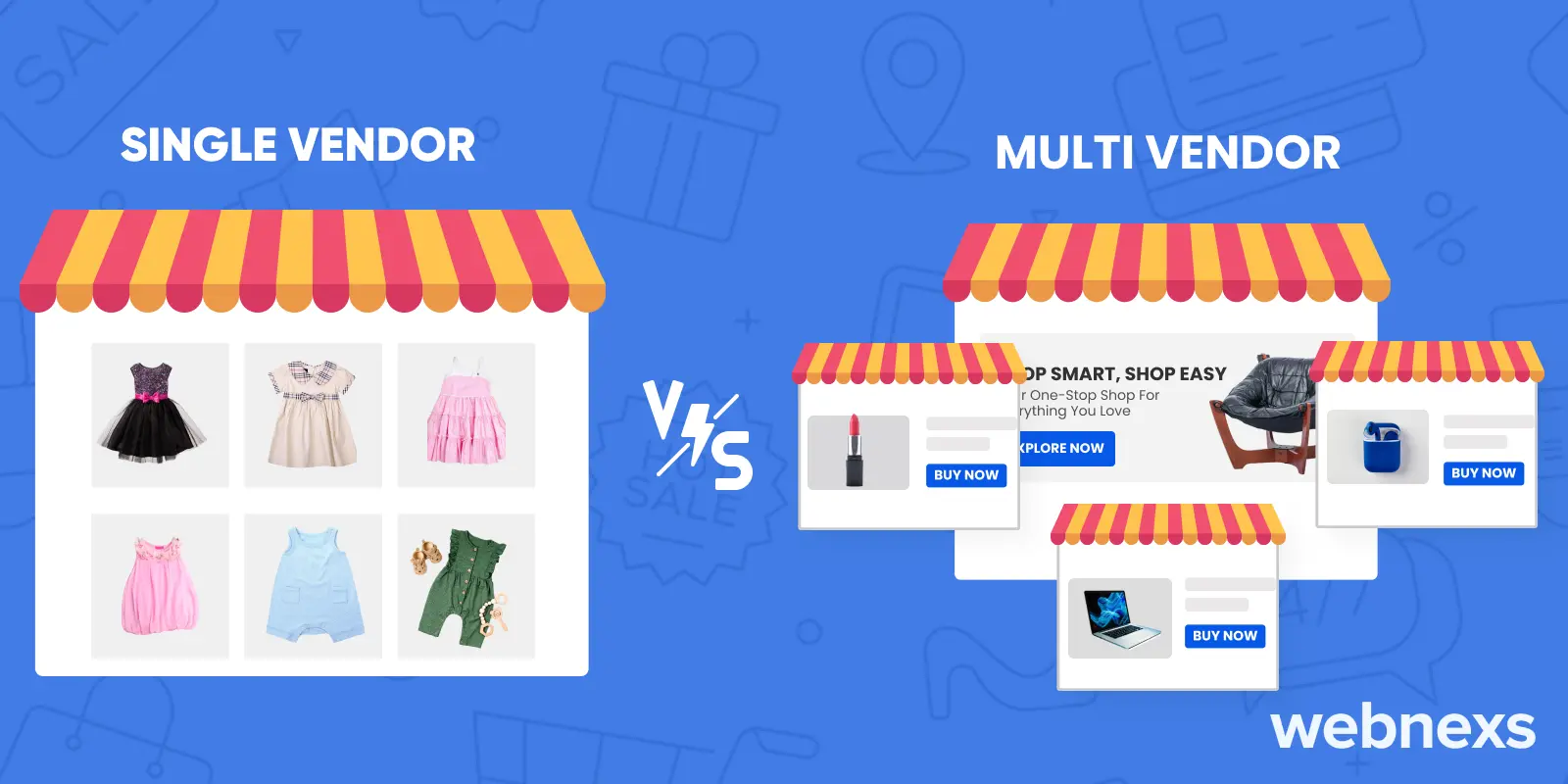





25 Responses
With multiple vendors, it is your responsibility to integrate everything. Very few outside vendors will be able to integrate everything into a single cohesive whole given the number of systems and the breadth of details—at least not without incurring significant costs.
Excellent article. Clearly explained about the diff of single and multi vendor. These article helps us to choose between the best one.
Thanks for sharing your information. Hey, all you know about Webnexs? Webnexs Multi-Vendor Solution comes with full source code that can be modified for any B2B eCommerce requirement. A fully-featured B2B eCommerce Solution.
Multi-vendor website: The price will be higher because you have to buy different modules to finish your solution. You are free to decide.
Multi-vendor solutions are typically more difficult to implement because you must coordinate the integration of multiple (and potentially incompatible) systems.
There are still a lot of legacy systems in use, including one known as the multi-vendor marketplace, even though there is undoubtedly a trend toward making everything compatible.
Alternately, they might simply succeed to the point where the larger competitors in the market decide to acquire them. There is no assurance that the online purchase will continue after that point.
With a single vendor, it is extremely unlikely that you will receive best-of-breed functionality for every feature. I’m saying it right now.
To make the most of your multi-vendor software e-commerce solution—and, indeed, corporate IT in general—you do need the training.
Multi-vendor solutions typically take longer to implement because you’ll need to coordinate the integration of numerous (and possibly incompatible) systems.
The main benefit of selecting a multi-vendor solution is, in essence, that it is multi-vendor. By choosing it, e-commerce will grow in scope.
Im a past client of Webnexs ecommerce, If you decide to connect your existing store to a third-party marketplace, Webnexs can help, too.
I’m glad to find another amazing eCommerce blogger who can go ease with the multi-vendor topics.
The blog is absolutely fantastic! A lot of great information can be helpful about the benefits of developing a multi-vendor website. Keep updating the blogs. thanks!
I’m glad to find another amazing multi-vendor marketplace development blogger.
This is actually quite significant. You want to receive product(s), upgrades, and service/support from your multi-vendor for many years to come, correct?
Thanks for putting your idea on differencing both the single and multi-vendor sites.
Thank you for sharing such a nice and informative Blog.
Instead of going with the single vendor site, let’s try the multi-vendor marketplace which is far superior, proactive and regular communication will help you to better set expectations with your supplier and avoid these headaches.
Whether you’re a buyer or seller, understanding how marketplaces work can help you maximize the benefits you get from this type of transaction.
Can you please explain, the factors to consider when deciding between single vendor vs. multi-vendor? thanks in advance.
I completely agree, It is great. And I am always surprised when I read posts about the multi-vendor marketplace. This is great content. I have learned something powerful today.
You should be able to identify one vendor who will probably be the best in one to several areas with careful selection. If you decide to go with this, make sure you finish your homework.
Nice post on single and multi-vendor marketplace. I learn something new and challenging on blogs I stumble upon every day. It’s always useful to read content from other writers and practice a little something from other sites.
Both of them are good, they can be single vendor or multi-vendor but if want to be visible to more people, then you should try the multi-vendor marketplace.